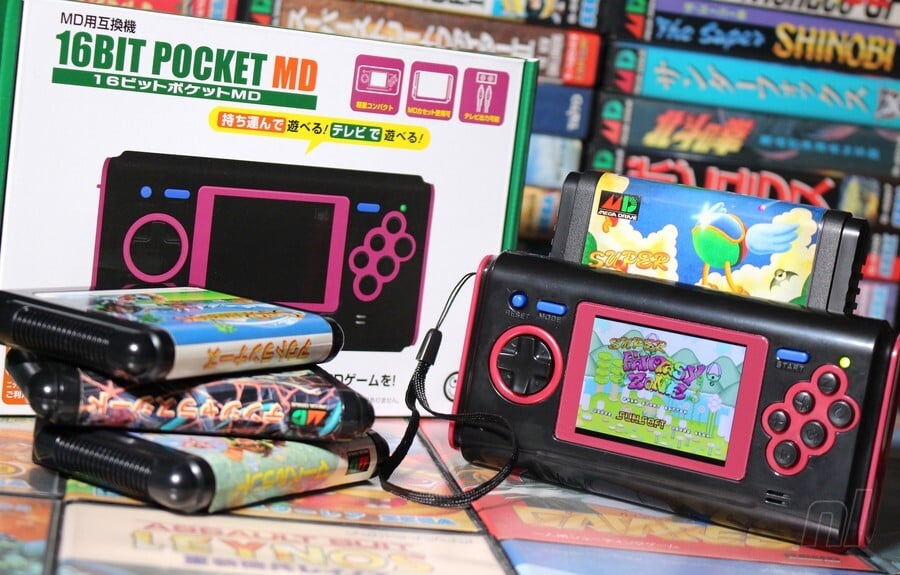
This year, Sega will release the Mega Drive Mini, its own take on the retro console craze which Nintendo has done rather well out of in recent years with the NES and SNES Classic Editions. However, it's not the first time that the SNES rival has been resurrected using modern technology; in fact, we've been seeing clones of the Mega Drive / Genesis for the past decade, the vast majority of which have been pretty terrible. Plagued by poor emulation, terrible controls and hopelessly inaccurate sound replication, these devices have been huge disappointments – and the ones which carry Sega's official blessing haven't been any better either, often exhibiting the same issues because they're based on largely the same 'system on a chip' tech.
When news hit our ears that Japanese company Columbus Circle – which has been doing a good job of resurrecting classic games in recent years – was about to release its own portable Mega Drive clone, we had little reason to suspect it would change this sorrowful tradition. Nonetheless, we duly ordered one – mostly out of morbid curiosity – and we've been pleasantly surprised. Not only does the unit come with a good screen that really makes the pixels stand out (although viewing angles aren't brilliant and some games appear slightly stretched), it also has a fantastic rolling D-pad and a six button setup which means you can play games like Super Street Fighter II perfectly (in case you were wondering, it works fine with games like Forgotten Worlds and Golden Axe II, both of which have issues with the official six-button controller on original hardware). It's also comfortable to use for prolonged periods and is highly portable. Oh, and Mega Everdrive carts work on it, if you're into that kind of jazz.
It's not perfect, by any means; the sound, while better than we've heard on other clones, still isn't quite right and bass notes cause the speaker to distort, even when it's at quite a low volume. The unit doesn't have an internal rechargeable battery either, and relies on four AAA batteries for power, which give around five to six hours of play. Despite the quality of the screen and the controls, the 16Bit Pocket MD looks and feels a little cheap, and almost looks like a prototype in some places; for example, on the top edge there's a 'DC 5V' mark next to a blank piece of plastic, which suggests that Columbus Circle had intended to include the ability to power the unit from a wall charger, but removed it at the last minute. Elsewhere, the casing doesn't quite fit together snugly enough, and we found that our copy of Virtua Racing – which includes Sega's Super FX-beating SVP chip – refused to boot. PAL and North American games with region locking refused to work too, which means the 16Bit Pocket MD is imitating a Japanese Mega Drive console on a hardware level.
The 16Bit Pocket MD also has AV-out support, but it's via composite and the quality is predictably poor; it's a nice bonus but not something you'll want to make much use of. The inability to plug in a second controller also means that you're limited to single-player games, both in TV-out mode and when used as a portable (Sega's own attempt at a portable Mega Drive, the Nomad, had a controller port on the bottom to overcome this).
In so many ways, the 16Bit Pocket MD repeats many of the mistakes other Sega clone systems have done; it's a cheaply-made device rather than a premium proposition. But it gets the most important things (mostly) right – the controls are great, the screen is good and, by and large, performance is of an acceptable standard (although those of you who refuse to accept anything but FPGA quality will no doubt find plenty of issues).
The really puzzling thing about the 16Bit Pocket MD is how hard it is to get hold of; our unit was pre-ordered via Play-Asia before Christmas and was subject to several release date delays before finally arriving this week. Play-Asia is now completely sold out, and a quick glance online appears to suggest that Amazon Japan and Columbus Circle's own online store are the only places that have stock right now. If you're brave enough to order from either then you can pick one up for around £43 / $55, not including international shipping. It's worth noting that Columbus Circle has also released a portable Super Famicom with HDMI-out support, although that appears to be just as hard to get as its Sega sibling.
If you do somehow manage to get your hands on a 16Bit Pocket MD, we can't imagine you'll be disappointed, especially for this price. While the Sega Nomad remains the portable console of choice for diehard Mega Drive / Genesis fans, its muddy screen and terrible battery life count against it in 2019; the 16Bit Pocket MD may not be perfect, but it does at least solve these two issues.
